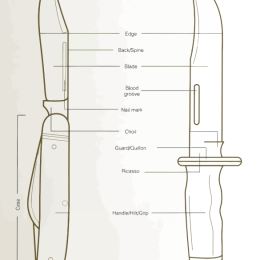Leisure & Home: A Fun Life is a Good Life

How to Choose and Use a Survival Knife (3)
Assessing Your Needs Choosing a knife could be one of the most important decisions you make before heading into the wilderness. The right knife can make almost everything you do …
There's a lot of societal pressure to live a productive life in which you contribute to the community in which you live. That's all fine and you won't get any argument from me about such a lofty goal. However, I think we also need to leave time to enjoy things we like doing whether they have a direct impact or not on the well being of anyone else. If I want to take photos of things that 1,000 other people have taken photos of, there's nothing wrong with that. If I want to spend a week every year diving in tropical waters and admiring sea life, there's nothing wrong with that either. And if I happen to enjoy learning how to survive in the wilderness, well that should be entirely my choice even if I spend most of my time in a concrete jungle.
This section on Infolific is dedicated to this idea of leisure time, hobbies, and enjoying your home. We really don't care what it is you do as long as you have fun doing it!
-

Understanding your draw options: A guide to multi-state and local games
-

Rabbit Pictures
-

Making It Work: Relationship Strategies for Loving a Capricorn Woman
-
Understanding Seed Types: A Simple Guide to Feminized, Indica-Type and Sativa-Type Varieties
-

Smart spending online: why low-deposit gaming options like NZ’s $2 casinos are gaining interest
-
Top Wall Paper Design Ideas for a Personalized Home Makeover
-

Scuba Diving in Belize
-

How to Choose Quality Cannabis Strains on a Budget
-

Discover Lithuania: Your Guide to Meeting Lithuanian Single Women and Exploring the Baltics
-

The Spin That Never Sleeps
-
How Do Double-Wall Paper Cups Redefine the On-the-Go Coffee Experience
-

Scuba Diving Gear: What You Should and Shouldn't Buy
-

A Collection of Frog Photos
-

The Big List of Trees and Shrubs for Bonsai
-

BetPokies NZ — Not Just Another Gambling Website: Track the Site’s Unique Features
-

Witz Waterproof Case Review
-
Mask Defog Gel or Spray?
-
Ambergris Caye Scuba Diving
-
Warm Water Hypothermia
-

High Risk, High Altitude: How Crash Games Are Redefining Online Gambling
-

The Timeless Charm of Holiday Cards
-
Scuba Diving Class – Day 2
-
Tree Based Survival Shelters
-
Mill File vs. Flat File: What’s the Real Difference?
-

The Ultimate Guide to Scuba Diving Trips in 2026: Your Gateway to Underwater Adventures
-
The Gentleman's Guide to Houston After Dark
-

Learning Through Play: What Crosswords and Card Games Teach Us
-

Photographing Monarch Butterflies Overwintering in Mexico
-

How To Document Your Event For Social Media In 2025
-
How to Buy a Guitar
-

Sustaining the Casino Game Library with Aviator and Other Games
-

Plant Pictures
-

Snake Pictures
-

How to Practice Smart Gambling: Avoiding Common Pitfalls and Myths
-
Sources of Bonsai Material
-
Navigating Underwater Without a Compass
-

Hiking in the Adirondacks High Peaks Region
-
Attract Hummingbirds And Butterflies To Your Garden
-
Surface Signaling Devices
-
Is It Legal to Live In The Wilderness?
-

Pleasure by Design: Exploring the World of Tailored Companionship
-
Swamp Survival in Georgia, USA
-

Sunset Pictures
-
Tour Group vs. Photo Tour Group
-

Grand Canyon Pictures
-

A Guide to Creating Your Own Custom Car Air Fresheners
-

Minimalism and Focus: Why Simpler Casino Games Are Making a Comeback
-

Buy Pop Cones' Products From Durity Distribution: Here's How & Why
-
Surviving a Sandstorm
-

Wiring the Trunk and Branches of Bonsai
-

How Is Online Poker Stamping Out Cheaters?
-

RTP (Return to Player) variations across game types
-
Dealing with Weather and the Environment
-
Wiring Bonsai
-
Taking the Best Nature Photographs
-

Exploring Non-Medical Cannabis at a Cincinnati Dispensary: Flowers, Edibles, Concentrates, and More
-

Extinct Casino Games and Why They Vanished
-
Open Water Dive Training – Day 1
-
What to Photograph When You Travel
-

Dating Trends That Will Shape the Future of Dating and Relationships
-

The Fine Art of Hydration for Healthy Cannabis Growth
-

Factors To Consider When Buying A Pool For The Family
-

Ways To Reduce Water In The Home
-

The Evolution of Casino Lobby Design: Navigation and Player Retention
-

Can You Dive With Chronic Sinus and Ear Problems?
-
Tools for Growing and Maintaining Bonsai
-
Bonsai Pests and Diseases
-
The Risk of Lead Poisoning From Scuba Diving Weights
-

Key Aspects Contributing to Reputable Casino Brands
-

How Online Casinos Handle Responsible Gambling and Player Protection
-
Using a Flash Outdoors
-
How to Find Subsurface Water in a Survival Situation
-
Train Locally or When On Vacation?
-

What Makes Some Slot Games More Addictive Than Others?
-

The Optimal Setting for Ducted Air Conditioning
-

Layering and Grafting Bonsai
-

5 Fun Ways to Introduce Imaginative Character Toys into Open-Ended Playtime
-
Signs and Symptoms of Nitrogen Narcosis
-

Shore Diving in Bonaire
-
How to Choose a Flagpole Holder for Your House
-

Kitchen Renovation Tips For A Beautiful And Functional Space
-
Games to Learn for Fun Betting
-

Oscillating Saw vs. Jigsaw: Which One Should You Use?
-
Bonaire Dive Shops and Operators
-

Different types of extreme outdoor activities
-

7 Key Steps to Adding an Extension to Your Home
-

Gaming fun at home: the advantages of online gambling
-

Rosin and BHO Extraction: Which One Aligns with Your Preferences?
-

The Growing Popularity of Themed Online Casinos
-
Dive Knife or Sea Snips?
-

Hobbies That Turned Into Storage Unit Treasures – For Someone Else That Is
-

Scuba Diving Photos: The Best of Flickr
-
Belize City Scuba Diving
-

Orchid Pictures
-
Violoncello: Over-Shadowed By the Violin But Worthy of Consideration
-

Watering and Feeding Your Bonsai
-

The Best of Underwater Photography Magazine
-
Does the Air Volume in a Scuba Tank Change As You Descend?
-
Be an Ethical Nature Photographer
-
The Importance of a Good Scuba Diving Buddy
-
Camera Lens Filters: An Introduction
-

Compact Guide to Bonaire Reef Fish and Creatures
-
Nature Photography On Your Own
-
Containers for Bonsai
-
Your Scuba Tank Comes Loose Underwater… Now What?
-

Transacting with Neteller at Online Casino
-
Emergency Survival Shelter
-

Squirrel Pictures
-
Bear Grylls vs. Les Stroud
-

Plant List & Reference Guide
-
How to Purify Water In Survival Situation
-
Tips for Entering and Exiting Surf
-

Group Bonsai Plantings
-

Birds of Prey Pictures
-
BlastMatch Fire Starter
-
Surviving in Cold Water
-
Sixty Feet Underwater and Can't Get Air
-

NY Botanical Garden Orchid Show Review
-

Chipmunk Pictures
-

Monarch Butterfly Pictures
-
Are Hoods Really Needed?
-

Bonsai Tree Pruning: The Right Approach for the Right Tree
-
Canadian Boreal Forest Survival
-

Tiger Pictures
-
Favorite Birthday Wish
-
Finding Lost Dive Buddies vs. Safe Ascent Procedures
-

Random (and Funny) Photos from Around the Web
-
Snow Based Survival Shelters
-

The Importance of Light for Nature Photography
-

Intova Dive Light Review
-
Glossary of Bonsai Terms
-

Workplace Humor in Images
-
Singing: An Intro to Being a Better Singer
-
Eating Bugs for Survival
-
Weight Distribution For Wreck Diving
-
Which Way is North?
-
Mountain Survival: Les Stroud Shows How to Get Out Alive
-

Insect Pictures
-
Surviving a Fall Through Ice
-

Waterfall Pictures
-

Snapping Turtle Pictures
-

Bonsai Root Pruning and Repotting
-
Distilling Water in the Wilderness
-
Bonsai Styles
-

Flower Pictures
-

Butterfly Pictures
-
How to Travel with Your Camera Gear
-
How to Display Bonsai
-
Photography Resources
-

Homemade Sauerkraut, Kimchi, Kombucha, and Vinegar
-
Emergency Water Supplies – Rain, Snow, Ice, and Dew
-

The Dark Side Bekons: Lucasfilm Sells
-
The Latest Research on Nitrogen Narcosis
-

Break The Monotony: Try A New Solitaire Experience
-

How to Choose and Use a Survival Knife
-
Survival Stress
-
Real World Diving Tips
-

Tree Pictures
-
Tortola Scuba Diving
-
5 Questions Every Scuba Diver Should Answer
-
Tripods, Monopods and Other Camera Supports
-

Understanding Compost: What You Need To Know
-

Harbor Bird Pictures
-
Jungle Survival in Costa Rica
-

Moon Pictures
-

16 of the Best Animal Photo Captions You'll Ever Read
-
Bonaire Shore Dives (North End)
-

Bird Pictures
-
Surviving When Lost at Sea
-
Oxygen Toxicity aka Oxtox
-
Belize Dive Operators
-
Roatan and Utila (Bay of Islands, Honduras) Dive Operators
-

The Doomsday Prepper’s Guide to Self Storage
-

Making House Cleaning Fun for Kids
-

The History and Evolution of Casino Gaming
-

Propagating Bonsai from Seed
-

Scorpion Stings: Painful, But Not Usually Lethal
-
Pruning a Cotoneaster Bonsai
-
Basic Bonsai Methods
-
Introduction to Nitrogen Narcosis
-
Scuba Diving Class – Day 3
-
WetFire Tinder
-
Nitrogen Narcosis: What Technical Divers Can Teach Us
-

Dive with Div'Ocean Bonaire
-

Elk Pictures
-
Behaviors of Those Suffering from Nitrogen Narcosis
-
Surviving After a Plane Crash
-

Optical Illusions and Other Mind-Bending Fun
-

Basic Scuba Diving Hand Signals
-

15 Funny Animal Signs
-

Cooking with Garden Grown Herbs
-

Gardening Calendar (Free Downloadable PDF)
-

Bonaire Boat Dives
-

Bonsai Quick Care Guide: What To Do With Your New Plant
-
Tarantula Bites
-

Glacier National Park: Mountains and Moose Everywhere You Turn
-
Desert Survival
-
Camera Exposure: An Introduction
-
Use Photography to Document Your Travels
-
How to Take a Good Picture of a Snake
-
How to Find Water
-

Crocodile Pictures
-
How to Remove a Leech
-

Florida Everglades Bird Pictures
-
Reducing the Effects of Nitrogen Narcosis
-

Aerial Photos
-
Preparing for the Open Water Dive Training
-

Safe, Long-Term Storage of Household Goods
-
Wiring a Juniper Bonsai
-

Bonsai Landscape Styles
-

Planting Bonsai on Rock
-
Bonsais Throughout the Seasons
-
Styles of Bonsai
-
The Art of Bonsai
-

How To Buy Budget-Friendly THC-O Vape?
-
Plants as a Survival Food Source
-

Dealing With Hypothermia
-
How to Take a Good Butterfly Picture
-
Death Valley Pictures
-
Start a Fire with a Gun: Is it a Myth?
-
A Brief History of the Piano
-
To See or Not To See, That is the Question
-

Casinos Strategies to Trick People Into Gambling More
-

Lizard Pictures
-
S.U.R.V.I.V.A.L., The US Army Way
-
Prioritizing and Improvising for Wilderness Survival
-

Homebrew Wine: Making Alcohol Through Fermentation
-
A Guide to Camera Lenses
-

I'm PADI Open Water Diver Certified!
-
Scuba Diving Class – Day 1
-
Composition: An Introduction
-

Underwater Pictures From a Florida Snorkeling Trip
-

Ancient Storage Techniques: How Did People Store Stuff In The Wild?
-
Choosing Trees and Shrubs for Bonsai
-
St. Croix Scuba Diving
-
VIP Diving Bonaire Review
-
Surviving in the Canyonlands of Utah
-

Horse Pictures
-

Scuba Divers, Pumpkins and Halloween!
-
Photography Books
-

How to Write With a Fountain Pen
-
Carrying Your Camera Gear
-

Animal Traps
-
The Worst Case Scenario Survival Handbook – Travel
-
Camera Flashes: An Introduction
-
How to Find Surface Water
-
Scuba Diving Instruction Manual and DVD
-
Surviving a Tsunami
-

Turtle Pictures
-

Landscape Photos


